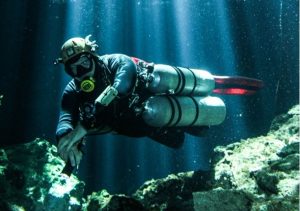I’ve found this article published by Curt Bowen in the Cave Diving Articles section of the Advenced Diver Magazine.
I think it’s an interesting read for all those who are interested in cave diving.
Located just a few kilometers south of Tulum, Quintana Roo, Mexico, Cenote Angelita appears ordinary from the surface with its circular shape and common vegetation until the water’s surface is broken and her treasures below are experienced.
White misty clouds encircle the divers as they descend for the first 50 feet. Like a skydiver dropping through the clouds, the divers descend below this white, misty layer to reveal one of the most unique and mystical views in the Riviera Maya.
Clear water allows unlimited visibility darkened only by the limited amount of sunlight gleaming through the recently broken clouds above. As the divers’ eyes adjust to the darkness, steep, pock-marked encircling limestone walls drop sharply into the ground.
Hovering motionless at 70 feet, the unique beauty of Angelita comes into view. Thirty feet below, brown hydrogen sulfide is forever trapped between the lighter freshwater above and the denser seawater below. Undisturbed, this cloud settles into a thick opaque layer that produces an optical illusion of a fake brown sand floor. Emerging from the cloud is the very top of a debris cone entangled with fallen trees and thick, white calcite mineral deposits. The tips of tree branches emerge randomly through the false floor. Like a scene from Sleepy Hollow, one awaits for the headless horseman to charge from the shadows in search of new heads.
Disturbing the hydrogen layer causes wisps of swirling clouds to encircle the divers. From above it appears as if the divers are swallowed into a pit of quicksand — even their lights are engulfed by the thick hydrogen.
Slowly dropping into the hydrogen layer, the divers’ bodies disappear as they are surrounded by the false floor. With the hydrogen layer a dark brown color, the divers’ bright cave lights become dim and seemingly useless. Dropping into the darkness for another 10 feet, the light slowly becomes brighter and brighter as the hydrogen cloud thins out and the divers enter the seawater below.
Emerging below the thick hydrogen sulfide cloud, a pungent taste and smell of rotten eggs can be sensed. The tree-covered debris cone descends deeper into the darkness below. Following the cone downwards the shapely walls come into view and intersect with the floor at a maximum depth of 203 feet. From the depths, if the divers turn out their lights, they can see a very faint brown glow with some reds and yellows churning as their bubbles break through the hydrogen clouds above.
Returning towards the surface the divers emerge from the hydrogen tomb below. The brown gas seems to cling to their bodies as they ascend upwards. Following the walls upwards, giant flowstone formations and steep undercuts are encountered between 30 and 10 feet. Exploring the circumference at this depth, small freshwater tunnels that are too small for exploration dart outwards and under the surrounding Mexican jungle. Running water and heavy mineral deposits stain the limestone making a majestic rock painting from nature.
Years ago divers discovered some Mayan pottery at 150 feet and Cenote Angelita was a well kept secret until some of the pottery disappeared. INAH, Mexico’s federal archaeology agency, closed the site and performed an investigation and excavation, leaving the dive site without the pottery but still with all its unworldly beauty.
Angelita is a guided dive location only with landowner permission.Entry fee is required before diving.

